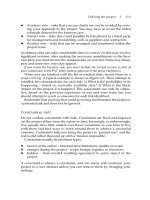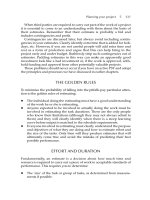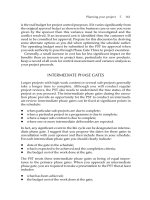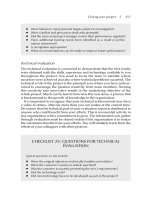Management a practical introduction 3rd kinicky chapter 01
Bạn đang xem bản rút gọn của tài liệu. Xem và tải ngay bản đầy đủ của tài liệu tại đây (211.21 KB, 35 trang )
Management
A Practical Introduction
Third Edition
Angelo Kinicki &
Brian K. Williams
Kinicki/Williams, Management: A Practical Introduction 3e ©2008, McGraw-Hill/Irwin
Chapter 1: The Exceptional Manager
What You Do, How You Do It
Rewards
Six Challenges
Four Functions
Levels & Areas of Management
Roles Managers Play
Entrepreneurship
Skills Managers Need
Kinicki/Williams, Management: A Practical Introduction 3e ©2008, McGraw-Hill/Irwin
1.1 Management: What It Is, What Its
Benefits Are
Management is defined as
1) the pursuit of organizational goals efficiently
and effectively by
2) integrating the work of people through
3) planning, organizing, leading, and controlling
the organization’s resources (four functions of
management)
Kinicki/Williams, Management: A Practical Introduction 3e ©2008, McGraw-Hill/Irwin
1.1 Management: What It Is, What Its
Benefits Are
where:
efficiency is the means of attaining the
organization’s goals
Efficient organizations use resources like
people, money, and raw materials wisely and cost
effectively
Kinicki/Williams, Management: A Practical Introduction 3e ©2008, McGraw-Hill/Irwin
1.1 Management: What It Is, What Its
Benefits Are
and:
effectiveness is the ends or goals the
organization is trying to achieve
Effective organizations achieve results, make
the right decisions, and successfully carry them
out so that the goals are achieved
Kinicki/Williams, Management: A Practical Introduction 3e ©2008, McGraw-Hill/Irwin
1.1 Management: What It Is, What Its
Benefits Are
WHY ORGANIZATIONS VALUE MANAGERS: THE
MULTIPLIER EFFECT
Good managers create value through the
multiplier effect where their influence on the
organization is multiplied beyond what could be
achieved by someone acting alone
The rewards of being an exceptional manager
typically include good salaries and many benefits
Kinicki/Williams, Management: A Practical Introduction 3e ©2008, McGraw-Hill/Irwin
1.1 Management: What It Is, What Its
Benefits Are
You can benefit from studying and practicing management
by
learning how to deal with organizations from the outside
understanding how to relate to supervisors and how to
interact with coworkers
understanding how to manage yourself in the workplace
experiencing a sense of accomplishment
stretching your abilities and magnifying your range of
accomplishments
building a catalog of successful products or services
Kinicki/Williams, Management: A Practical Introduction 3e ©2008, McGraw-Hill/Irwin
Chapter 1: The Exceptional Manager
CLASSROOM PERFORMANCE SYSTEM
Which of the following is not a reward from studying
management?
A) building a catalog of successful products or services
B) understanding how to relate to supervisors
C) understanding how to interact with coworkers
D) understanding how to deal with organizations from the
outside
Kinicki/Williams, Management: A Practical Introduction 3e ©2008, McGraw-Hill/Irwin
1.2 Six Challenges To Being
A Star Manager
To be a star manager, you need to
1. manage for competitive advantage
2. manage for diversity in race, ethnicity, gender,
and so on
3. manage for the effects of globalization
4. manage for the effects of information
technology
5. manage to maintain ethical standards
6. manage for the achievement of your own
happiness and lifetime goals
Kinicki/Williams, Management: A Practical Introduction 3e ©2008, McGraw-Hill/Irwin
1.2 Six Challenges To Being
A Star Manager
CHALLENGE #1: MANAGING FOR COMPETITIVE
ADVANTAGE—STAYING AHEAD OF RIVALS
Competitive advantage is the ability of an
organization to produce goods or services more
efficiently than competitors do, thereby
outperforming them
Kinicki/Williams, Management: A Practical Introduction 3e ©2008, McGraw-Hill/Irwin
1.2 Six Challenges To Being
A Star Manager
In order to stay ahead of rivals, firms need to be
better at responding to:
customers
innovation
quality
efficiency
Kinicki/Williams, Management: A Practical Introduction 3e ©2008, McGraw-Hill/Irwin
Chapter 1: The Exceptional Manager
CLASSROOM PERFORMANCE SYSTEM
In order to stay ahead of rivals, firms need to be better at
all of the following except
A) innovation
B) implementation
C) efficiency
D) quality
Kinicki/Williams, Management: A Practical Introduction 3e ©2008, McGraw-Hill/Irwin
1.2 Six Challenges To Being
A Star Manager
CHALLENGE #2: MANAGING FOR DIVERSITY—
THE FUTURE WON’T RESEMBLE THE PAST
In the future, managers will be challenged to
maximize the contributions of employees that are
diverse in gender, age, race, and ethnicity
Kinicki/Williams, Management: A Practical Introduction 3e ©2008, McGraw-Hill/Irwin
1.2 Six Challenges To Being
A Star Manager
CHALLENGE #3: MANAGING FOR
GLOBALIZATION—THE EXPANDING
MANAGEMENT UNIVERSE
Managing for globalization is a complex,
ongoing challenge
It is important for managers to understand how
cultural differences affect an organization
Kinicki/Williams, Management: A Practical Introduction 3e ©2008, McGraw-Hill/Irwin
1.2 Six Challenges To Being
A Star Manager
CHALLENGE #4: MANAGING FOR INFORMATION
TECHNOLOGY
Managing the Internet (the global network of
independently operating but interconnected
computers, linking hundreds of thousands of
smaller networks around the world) is perhaps
the biggest information technology challenge for
managers
Kinicki/Williams, Management: A Practical Introduction 3e ©2008, McGraw-Hill/Irwin
1.2 Six Challenges To Being
A Star Manager
E-commerce (electronic commerce—the buying
and selling of goods or services over computer
networks) is changing the way entire industries work
Information technology has facilitated e-business
(using the Internet to facilitate every aspect of
running a business), e-mail (text messages and
documents transmitted over a computer network)
and project management software (programs for
planning and scheduling the people, costs, and
resources to complete a project on time)
Kinicki/Williams, Management: A Practical Introduction 3e ©2008, McGraw-Hill/Irwin
1.2 Six Challenges To Being
A Star Manager
Thanks to new technologies, employees may
telecommute (work from home or a remote location
using a variety of information technologies)
use videoconferencing video and audio links along with
computers that let people in different locations see, hear,
and talk with one another)
engage in collaborative computing (state-of-the-art
computer software and hardware that helps people work
better together)
use knowledge management (implementing of systems
and practices to increase the sharing of knowledge and
information throughout an organization)
Kinicki/Williams, Management: A Practical Introduction 3e ©2008, McGraw-Hill/Irwin
1.2 Six Challenges To Being
A Star Manager
CHALLENGE #5: MANAGING FOR ETHICAL
STANDARDS
Pressure to meet sales, production, and other
targets can create ethical dilemmas for managers
CHALLENGE #6: MANAGING FOR YOUR OWN
HAPPINESS AND LIFE GOALS
Managers need to consider whether meeting the
organization’s challenges is also personally
fulfilling
Kinicki/Williams, Management: A Practical Introduction 3e ©2008, McGraw-Hill/Irwin
1.3 What Managers Do:
The Four Principal Functions
WHAT MANAGERS DO: THE FOUR PRINICPAL
FUNCTIONS
Four functions: planning, organizing, leading,
and controlling make up the management
process
Kinicki/Williams, Management: A Practical Introduction 3e ©2008, McGraw-Hill/Irwin
1.3 What Managers Do:
The Four Principal Functions
Figure
TheManagement
Management Process
Figure
1.1:1.1:
The
Process
Kinicki/Williams, Management: A Practical Introduction 3e ©2008, McGraw-Hill/Irwin
1.3 What Managers Do:
The Four Principal Functions
Planning is setting goals and deciding how to
achieve them
Organizing involves arranging tasks, people,
and other resources to accomplish work
Leading is defined as motivating, directing, and
otherwise influencing people to work hard to
achieve the organization’s goals
Controlling involves monitoring performance,
comparing it with goals, and taking corrective
action as needed
Kinicki/Williams, Management: A Practical Introduction 3e ©2008, McGraw-Hill/Irwin
1.4 Pyramid Power: Levels &
Areas of Management
PYRAMID POWER: LEVELS & AREAS OF
MANAGEMENT
There are three levels of management: top,
middle, and first line
Managers can also be general managers and
functional managers
While the traditional management structure is a
pyramid-like model with the CEO at the top and
layers of managers below, the model of the future
is more like an orchestra where workers are the
musicians, and their manager is the conductor
Kinicki/Williams, Management: A Practical Introduction 3e ©2008, McGraw-Hill/Irwin
1.4 Pyramid Power: Levels &
Areas of Management
Figure 1.2: The Levels and Areas of Management
Kinicki/Williams, Management: A Practical Introduction 3e ©2008, McGraw-Hill/Irwin
Chapter 1: The Exceptional Manager
CLASSROOM PERFORMANCE SYSTEM
Which of the following is not one of the four
management functions?
A) planning
B) controlling
C) leading
D) implementing
Kinicki/Williams, Management: A Practical Introduction 3e ©2008, McGraw-Hill/Irwin
1.4 Pyramid Power: Levels &
Areas of Management
Top managers make long-term decisions about
the overall direction of the organization and
establish the objectives, policies, and strategies for
it
Middle managers implement the policies and
plans of the top managers above them and
supervise and coordinate the activities of the firstline managers below them
First line managers make short-term operating
decisions, directing the daily tasks of nonmanagerial personnel
Kinicki/Williams, Management: A Practical Introduction 3e ©2008, McGraw-Hill/Irwin









